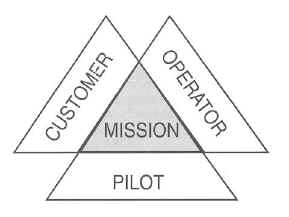TP 10112 - Helicopter Risk Management
(PDF, 52 KB)
If the customer, operator, and pilot can work in harmony, the goals of each can be achieved without jeopardizing mission safety.
It is a fact that some form of human error is involved in about 80% of all accidents. Mechanical failures, when they do happen, are not nearly as catastrophic as they were 20 years ago. Consequently, accident prevention programs are focusing on human factors and the necessity for eliminating as many hazards as possible before takeoff. One such factor is the triangular relationship between the customer, operator, and pilot. Unless there is a solid understanding and respect for the needs of each, the pilot can unnecessarily become the victim of the other two.
The helicopter pilot is particularly vulnerable. Much of the business is cyclical, with frantic periods of activity in the spring, summer and fall. The desire to maximize production and reduce costs can put an unnecessary strain on a pilot already faced with a hazardous task. Stress and fatigue are often products of customer and operator pressures. This, combined with personality factors, can quickly overload the pilot.
The triangular relationship between the customer, operator and pilot is an intricate play on personalities and conflicting opinions on task accomplishment. The customer's goal is to accomplish the task as quickly as possible within the allotted budget. The operator is profit-motivated, while the pilot's needs are not so clearly defined. In the early stages, he or she is motivated by the desire to fly. Once that desire is satisfied, monetary rewards can take precedence and in later years, time home with the family becomes important. Through these stages, though, is an overriding need for personal safety. The pilot that is unable to defend him- or herself can quickly become the victim of the unscrupulous customer or operator.
The antidote is a three-pronged message:
The customers must be made aware of the limitations of the helicopter and crew. They must accept the flight crew as competent and capable of analyzing difficult missions and assessing potential hazards. Flight crews must have the final say on mission procedures.
The operators' role is more complex. They have a duty to provide the right helicopter and the right pilot for the job. However, equally important is a support system for the pilot. This support begins with customer contract negotiations, at which time the operator can outline flight safety procedures. And, the support must continue on the job. Standard operating procedures (SOP) must be established and field maintenance must be available. Most importantly, management must display, to both customer and pilot, their loyalty and backing of flight crew decisions made on the job. Management-by-coercion has no place in the industry. Pilots must be able to perform their duties without fear of prosecution.
Pilots should learn to recognize their own negative (aggressive or withdrawn) behaviour and work on strengthening the positive (assertive) aspects of their personality. The desire to please should not interfere with mission safety. Their self-management and the flight profile are complicated enough without introducing customer and operator pressures. The pilot faced with a four-week shift in the bush can easily feel an apparent lack of control over life events, e.g., separation from family. Some pilots may be demoralized before the job begins. Operator and customer pressures will only amplify these feelings.
The triangular relationship is an intricate and complicated play on personalities. Understanding the priorities of the other two is a start. Positive motivation through effective training, sound maintenance, and SOPs will encourage and sustain a positive attitude in the cockpit. If the three players work in harmony, the goals of each can be achieved without jeopardizing mission safety.
Contact your Regional System Safety Officer regarding the video, Helicopter Risk Management.
